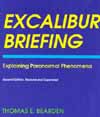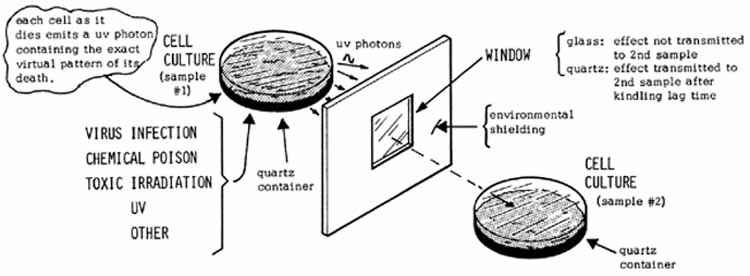|
DEATH TRANSMISSION VIA
THE PARANORMAL CHANNEL
As an example of
the kindling effect and the variability of photon quenching of the
paranormal channel, some extremely interesting experiments were performed
by V.P. Kaznacheyev et al regarding the paranormal transmission of death.
Briefly, two groups of cells were selected from the same cell culture and
one sample placed on each side of a window joining two environmentally
shielded rooms. The cell cultures were in quartz containers.
One cell culture was used as the initiation sample and was subjected to a
deadly mechanism - virus, germ, chemical poison, irradiation, ultraviolet
rays, etc. The second cell culture was observed, to ascertain any
transmitted effects from the culture sample being killed.
When the window was made of ordinary glass, the
second sample remained alive and healthy. When the window was made
of quartz, the second sample sickened and died with
the same symptoms as the primary sample. The experiments were done
in darkness, and over 5,000 were reported by Kaznacheyev and his
colleagues. The onset of induced complementary sickness and death in
the second culture followed a reasonable time - say two to four hours -
behind sickness and death in the primary culture.
The major transmission difference between window
glass and quartz is that quartz transmits both ultraviolet and infrared
well, while glass is relatively opaque to ultraviolet and infrared.
Both quartz and glass transmit visible light. Thus glass is a
suppressor of the paranormal channel, while quartz is not.
By performing the experiment in darkness through a
quartz window, the four-law patterns of disease, sickness, or death
engendered in the primary sample are not extensively squelched by the
photon interaction, and these four-law patterns are transmitted through
the quartz window into the second cell culture. Since the genetic
patterns of the second culture are the same as those of the first,
sympathetic four-state interaction and eventual kindling occur, resulting
in the appearance of the effects in the second culture.
It is well known that cells also emit mitogenic
radiation, including radiation in the ultraviolet and infrared regions.
Since these same regions are not strongly suppressed by the photon
interaction, one may hypothesize that paranormal effects may be strongly
modulated onto infrared and ultraviolet photon activity, and there is
indeed evidence for such an assumption. In 1950, Western researchers
found that cells could be killed in darkness with ultraviolet radiation,
kept shielded from visible light for twenty-four hours or longer, and then
if radiated with visible light the cells would start reviving by hundreds
of thousands even though they had been clinically dead.
Specifically, every cell emits mitogenetic
radiation in the ultraviolet twice: when it is born and when it dies.
The UV photon emitted at death contains the exact virtual state pattern of
the condition of the cell at death. The healthy cells are bombarded
with death messages from those that are dying, and this diffuses the death
pattern throughout the healthy culture, eventually kindling into the same
death pattern there.
However, the squelching of the paranormal channel
by photon interaction is never complete, or paranormal phenomena could
never occur in daylight. Hence paranormal patterns can be modulated
even onto visible light, although only extremely weakly. Thus we may
speak of the Q or sharpness of the paranormal modulation upon
photon frequencies; Q is extremely low for visible light and may be
extremely high for infrared and ultraviolet. In the visible light
spectrum, it is probable that extremely large numbers of near-zero
strength paranormal patterns are modulated on the light radiation; hence
these patterns simply consist of a very weak background noise and the
kindling effect does not apply. (The patterns are so random as to be
self-canceling in the kindling effect.)
Next Chapter |

